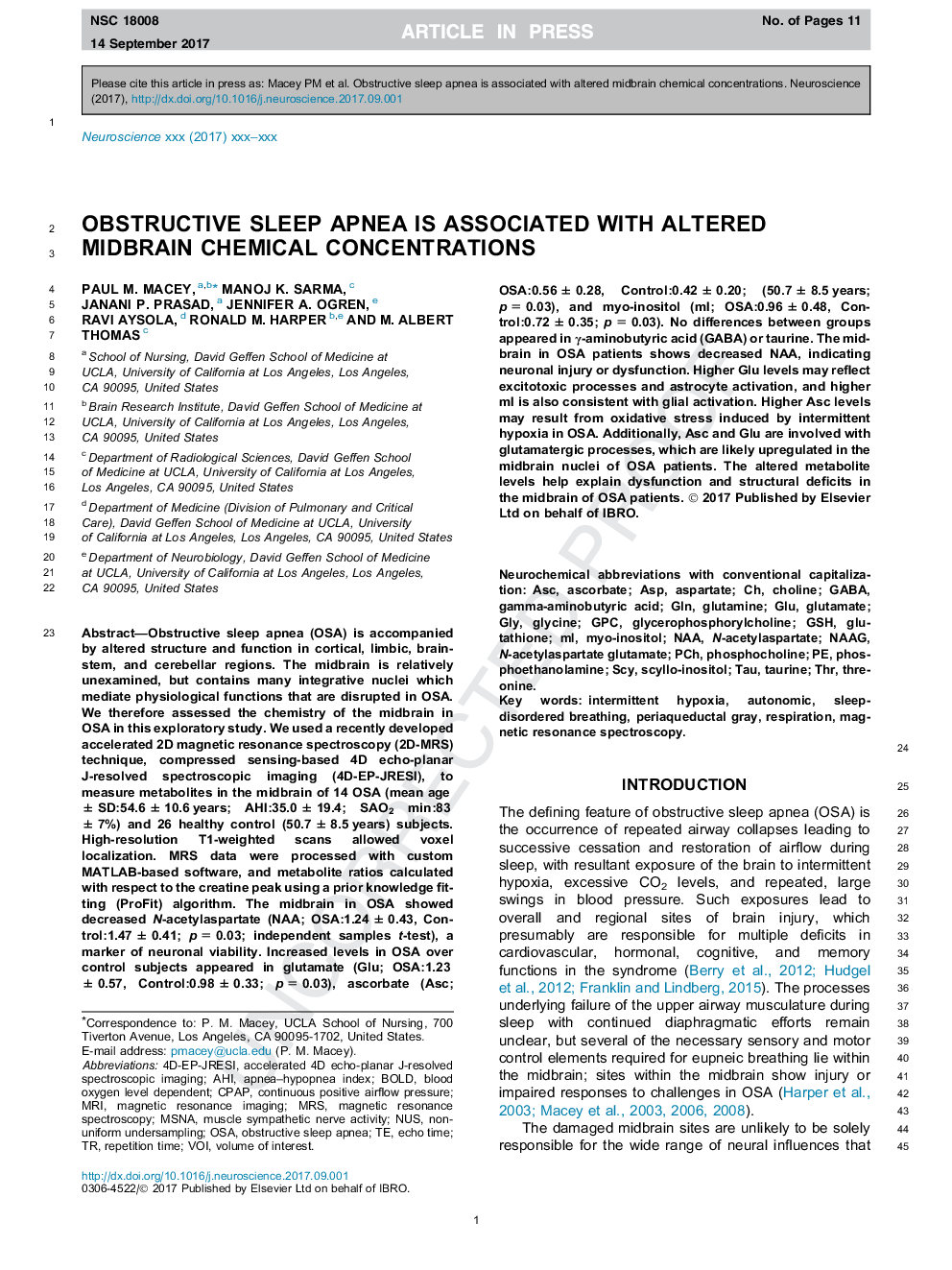| کد مقاله | کد نشریه | سال انتشار | مقاله انگلیسی | نسخه تمام متن |
|---|---|---|---|---|
| 5737339 | 1614713 | 2017 | 11 صفحه PDF | دانلود رایگان |
عنوان انگلیسی مقاله ISI
Obstructive sleep apnea is associated with altered midbrain chemical concentrations
ترجمه فارسی عنوان
آپنه انسدادی خواب با غلظت های شیمیایی متداول متابولیسم همراه است
دانلود مقاله + سفارش ترجمه
دانلود مقاله ISI انگلیسی
رایگان برای ایرانیان
کلمات کلیدی
NUSCPAPPE, phosphoethanolamineMI, myo-inositolaHIBOLDMRSGPC, glycerophosphorylcholineAsc, ascorbate - ASC، آسکورباتAsp, aspartate - Asp، آسپارتاتVOI - CANGABA, gamma-aminobutyric acid - GABA، گاما آمینوبوتیریک اسیدGLU, glutamate - GLU، گلوتاماتNAA, N-acetylaspartate - NAA، N-acetylaspartateMSNA - SNAThr, threonine - THR، ترئونینobstructive sleep apnea - آپنه خواب انسدادیsleep-disordered breathing - اختلال تنفسی در خوابMRI - امآرآی یا تصویرسازی تشدید مغناطیسیOsa - بخشTau, taurine - تاو، تائورینMagnetic resonance imaging - تصویربرداری رزونانس مغناطیسیRespiration - تنفسvolume of interest - حجم سودperiaqueductal gray - خاکستری پرآبیAutonomic - خودمختاریecho time - زمان اکوRepetition time - زمان تکرارblood oxygen level dependent - سطح اکسیژن خون وابسته استapnea–hypopnea index - شاخص آپنه-هیپوپنیmagnetic resonance spectroscopy - طیف سنجی رزونانس مغناطیسیmuscle sympathetic nerve activity - فعالیت عصبی سمپاتیک عصبیintermittent hypoxia - هیپوکسی متناوبCh, choline - چ، کولینGln, glutamine - گلن، گلوتامینGSH, glutathione - گلوتاتیونGly, glycine - گلی، گلیسین
موضوعات مرتبط
علوم زیستی و بیوفناوری
علم عصب شناسی
علوم اعصاب (عمومی)
چکیده انگلیسی
Obstructive sleep apnea (OSA) is accompanied by altered structure and function in cortical, limbic, brainstem, and cerebellar regions. The midbrain is relatively unexamined, but contains many integrative nuclei which mediate physiological functions that are disrupted in OSA. We therefore assessed the chemistry of the midbrain in OSA in this exploratory study. We used a recently developed accelerated 2D magnetic resonance spectroscopy (2D-MRS) technique, compressed sensing-based 4D echo-planar J-resolved spectroscopic imaging (4D-EP-JRESI), to measure metabolites in the midbrain of 14 OSA (mean age ± SD:54.6 ± 10.6 years; AHI:35.0 ± 19.4; SAO2 min:83 ± 7%) and 26 healthy control (50.7 ± 8.5 years) subjects. High-resolution T1-weighted scans allowed voxel localization. MRS data were processed with custom MATLAB-based software, and metabolite ratios calculated with respect to the creatine peak using a prior knowledge fitting (ProFit) algorithm. The midbrain in OSA showed decreased N-acetylaspartate (NAA; OSA:1.24 ± 0.43, Control:1.47 ± 0.41; p = 0.03; independent samples t-test), a marker of neuronal viability. Increased levels in OSA over control subjects appeared in glutamate (Glu; OSA:1.23 ± 0.57, Control:0.98 ± 0.33; p = 0.03), ascorbate (Asc; OSA:0.56 ± 0.28, Control:0.42 ± 0.20; (50.7 ± 8.5 years; p = 0.03), and myo-inositol (mI; OSA:0.96 ± 0.48, Control:0.72 ± 0.35; p = 0.03). No differences between groups appeared in γ-aminobutyric acid (GABA) or taurine. The midbrain in OSA patients shows decreased NAA, indicating neuronal injury or dysfunction. Higher Glu levels may reflect excitotoxic processes and astrocyte activation, and higher mI is also consistent with glial activation. Higher Asc levels may result from oxidative stress induced by intermittent hypoxia in OSA. Additionally, Asc and Glu are involved with glutamatergic processes, which are likely upregulated in the midbrain nuclei of OSA patients. The altered metabolite levels help explain dysfunction and structural deficits in the midbrain of OSA patients.
ناشر
Database: Elsevier - ScienceDirect (ساینس دایرکت)
Journal: Neuroscience - Volume 363, 5 November 2017, Pages 76-86
Journal: Neuroscience - Volume 363, 5 November 2017, Pages 76-86
نویسندگان
Paul M. Macey, Manoj K. Sarma, Janani P. Prasad, Jennifer A. Ogren, Ravi Aysola, Ronald M. Harper, M. Albert Thomas,
